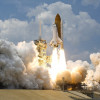The Chemistry of Fireworks
Interview with
Chris - So as a pyrotechnics expert, you like blowing things up. What a great job to have for a living!
Jacqueline - Yes it's fascinating. It means I can practice my chemistry. Explosions and fireworks are just chemistry.
Chris - How did you get into blowing things up?
Jacqueline - Well, when I became a lecturer at Cranfield University, I was trained in polymer chemistry. My professor at the time was an expert in explosives. I then realised that polymers and explosives come together quite nicely in polymer bonded explosives and so I got involved with putting explosives intoa polymeric network.
Chris - So for the lay person, a polymeric network means what?
Jacqueline - Polymers are like plastics, so what you do is take explosive crystals and embed them in a plastic network, which holds all of the explosives together.
Chris - What, so they're held together in just the right way that they go off efficiently?
Jacqueline - Well not really. It's like a binder. So if you think of when you're making bread dough and how eggs bind flour together, and then when it's cooked you get bread. Polymers are exactly the same. They start off wet, and then when you put it in the oven, it reacts and forms a solid lump, embedding all the explosive crystals.
Chris - Now let's talk about fireworks for a bit. How do you make fireworks so that they produce these fantastic shapes? How do you make a starburst that has arms that spread out equally and then have secondary explosions that turn from red to blue to green?
Jacqueline - First of all, the various shapes are called mortar bombs. It's like a very large football that has small fireworks in called fountains. To make the design you want to see in the sky, you put it together on a much smaller scale. For instance, if you want a heart, you arrange these small little fireworks into a heart shape. When the mortar is sent up into the sky and bursts apart, the small fireworks are sent out and burn in a heart shape. To get the change in colour, you have small pellets. One pellet will contain a substance that will burn red, and then you add a compound called strontium to that, and you attach that to another pellet that might burn with green. When it's I the sky with a mortar bomb, the red bit burns first, and then when it burns through and meets a green composition, you get a green colour second.
John - I was once told that the way to judge a firework display was the quality of the blues that can be produced in the sky. And I know for example that purples are very rare indeed. Why is that?
Jacqueline - Blue is a really hard colour to produce. To get blue, you need to add a composition that contains copper. The blue you are actually seeing is copper chloride. We have to add some chlorine to it because chlorine seems to intensify flame colour. Copper chloride is a very unstable species, and if the flame temperature is too high, copper chloride breaks apart and you don't see blue. So we have to try and keep the flame cool long enough so that the copper chloride stays stable and you get to see that blue colour.
John - And why do you never see purple?
Jacqueline - Well purple again is quite a difficult colour to produce. To get purple you have to mix to compounds together. You can mix for instance red with yellow to get orange, but blue is so unstable that it's hard to mix it with other compositions.
凯瑟琳-当you see fireworks that make noise, such as whistling and crackling, what's the chemical basis behind making those kinds of noises?
Jacqueline - The crackling noise is produced by burning titanium metal flakes. Titanium has a oxide layer, but the oxide layer is very thick compared to the oxide layer around magnesium or aluminium.
Chris - And that's what stops the air getting to it to burn, is that what you're saying?
Jacqueline - All metals will have an oxide layer. What happens is, when you've got titanium inside a flame, the metal actually melts and the oxide layer cracks open. So the metal doesn't actually burn, it melts. When the oxide layer cracks open, then you start getting your white sparks. So the breaking open of the thick oxide layer is the crackle sound.
Chris - But what about the squeaky noises? Do they embed something into the firework so it makes a whistle sound?
Jacqueline - No. What happens with the whistler rocket is that you have your rocket whistler composition, and it's in a cardboard tube that's only filled a quarter of the way at the top end of the tube. The rest of the tube is open. When you ignite your whistler from the open ended cardboard tube, as it burns, you get small sparks and explosions occurring. These small explosions cause the cardboard tube to vibrate. As it's vibrating, just like a tuning fork, you actually get a resonant sound occurring.
Catherine - What do you think the future of fireworks is? Where do you think we're going to see them going next?
Jacqueline - There are some new fireworks being developed, but the most important thing for fireworks will be the safety aspect. At the moment, all fireworks are made by hand, and most commercial ones are being imported from China. If there are accidents, people can die. Automating the process would make it much safer. That's the first thing. The second thing is safety of the users.
Catherine - And the third thing is surely the biggest firework in the world!
- PreviousFlying Into Hurricane Rita
- NextThe History of Rocketry









Comments
Add a comment